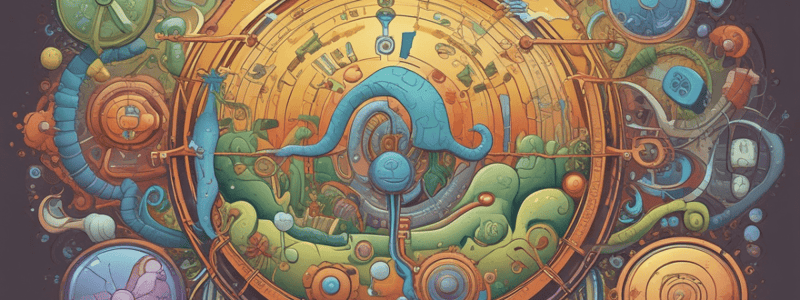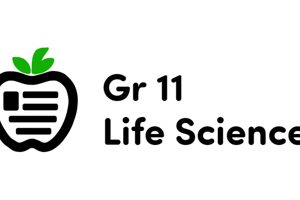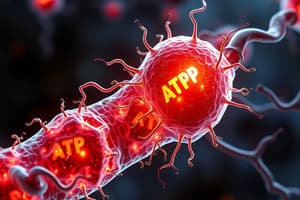Podcast
Questions and Answers
Which hormone inhibits fatty acid synthesis by diminishing the production of pyruvate?
Which hormone inhibits fatty acid synthesis by diminishing the production of pyruvate?
- Glucagon (correct)
- Cortisol
- Insulin
- Estrogen
During the early fasting stage, what does glucagon promote the release of by adipose tissue?
During the early fasting stage, what does glucagon promote the release of by adipose tissue?
- Fatty acids (correct)
- Amino acids
- ATP
- Glucose
What happens to the liver during the refeeding stage after breakfast?
What happens to the liver during the refeeding stage after breakfast?
- Shifts from glucose to fatty acids for energy
- Absorbs glucose from the blood
- Remains in a gluconeogenic mode (correct)
- Stops gluconeogenesis
Which metabolic process is responsible for converting glucose into ATP in anaerobic conditions?
Which metabolic process is responsible for converting glucose into ATP in anaerobic conditions?
What is the main target organ for glucagon in the body?
What is the main target organ for glucagon in the body?
Which process results in the shift of fuel from glucose to fatty acids by muscle and liver?
Which process results in the shift of fuel from glucose to fatty acids by muscle and liver?
What is the reason that β-oxidation of fatty acids by muscle halts the conversion of pyruvate into acetyl CoA?
What is the reason that β-oxidation of fatty acids by muscle halts the conversion of pyruvate into acetyl CoA?
During days 1-3 of starvation, what is a significant raw material for glucose synthesis in the liver?
During days 1-3 of starvation, what is a significant raw material for glucose synthesis in the liver?
Which compound must be converted to Ketone Bodies on days 3-7 of starvation due to its inability to leave liver cells?
Which compound must be converted to Ketone Bodies on days 3-7 of starvation due to its inability to leave liver cells?
What is the primary reason for the liver to produce large amounts of Ketone Bodies during extended starvation?
What is the primary reason for the liver to produce large amounts of Ketone Bodies during extended starvation?
Which compound is considered a "portable" form of Acetyl CoA, mainly produced in the liver's mitochondria?
Which compound is considered a "portable" form of Acetyl CoA, mainly produced in the liver's mitochondria?
In the context of energy generation during starvation, which molecules contribute to the production of Acetyl CoA?
In the context of energy generation during starvation, which molecules contribute to the production of Acetyl CoA?
What are the primary fuels for heart and skeletal muscle during starvation?
What are the primary fuels for heart and skeletal muscle during starvation?
Which organ uses lactate for fuel during a period of 1-3 days of starvation?
Which organ uses lactate for fuel during a period of 1-3 days of starvation?
What process becomes the primary source of glucose during the 1-3 days of starvation?
What process becomes the primary source of glucose during the 1-3 days of starvation?
Which fuel becomes the primary source for the brain after 3-7 days of starvation?
Which fuel becomes the primary source for the brain after 3-7 days of starvation?
What leads to death during starvation?
What leads to death during starvation?
Which event is an example of studying the effects of intrauterine deprivation and subsequent adult health?
Which event is an example of studying the effects of intrauterine deprivation and subsequent adult health?
What is the primary role of gluconeogenesis during starvation?
What is the primary role of gluconeogenesis during starvation?
What happens to the fuel used by muscle during starvation?
What happens to the fuel used by muscle during starvation?
What is the normal glucose concentration that the human body attempts to maintain?
What is the normal glucose concentration that the human body attempts to maintain?
What is the result of the action of pyruvate carboxylase and PEP carboxykinase in gluconeogenesis?
What is the result of the action of pyruvate carboxylase and PEP carboxykinase in gluconeogenesis?
Why can't fatty acids be converted into glucose?
Why can't fatty acids be converted into glucose?
What is the role of pancreatic islets of Langherhans in glucose homeostasis?
What is the role of pancreatic islets of Langherhans in glucose homeostasis?
What is the primary source of energy during prolonged starvation?
What is the primary source of energy during prolonged starvation?
During periods of fasting, what happens to the release of fatty acids?
During periods of fasting, what happens to the release of fatty acids?
What is the enzyme responsible for converting fructose 1,6-bisphosphate to fructose 6-phosphate?
What is the enzyme responsible for converting fructose 1,6-bisphosphate to fructose 6-phosphate?
What is the process by which glucose is synthesized from non-carbohydrate sources during fasting?
What is the process by which glucose is synthesized from non-carbohydrate sources during fasting?
What is the primary source of energy for the liver and muscle during periods of fasting?
What is the primary source of energy for the liver and muscle during periods of fasting?
What is the process by which glucose is converted into energy in the presence of oxygen?
What is the process by which glucose is converted into energy in the presence of oxygen?
Flashcards are hidden until you start studying
Study Notes
Cellular Metabolism
- Cellular metabolism involves converting energy from food into cellular energy (ATP)
- Processes involved: beta oxidation, glycolysis, anaerobic oxidative deamination, and electron transport and oxidative phosphorylation
Fat and Glucose Metabolism
- Glucagon increases lipolysis and inhibits fat synthesis
- Fat is stored in adipose tissue and released as fatty acids during fasting
- Glucose is stored in the liver and muscles as glycogen, and released during fasting
Stages of Fasting
- Post-absorptive stage: after a meal, glucose and amino acids are transported to the blood, and lipids are packed into chylomicrons and transported to the blood via the lymphatic system
- Early fasting stage: during the night, glucagon levels increase, and glucose and insulin levels decrease, leading to glycogen breakdown and fatty acid release
- Refed stage: after breakfast, the liver remains in a gluconeogenic mode, and newly synthesized glucose is used to replenish liver glycogen stores
Glucose Metabolism During Starvation
- Days 1-3: glucose is synthesized from alanine, lactate, and pyruvate through gluconeogenesis in the liver
- Days 3-7: acetyl-CoA is converted to ketone bodies (acetoacetate, d-3-hydroxybutyrate, and acetone) in the liver, which are then used as fuel by the heart, skeletal muscle, and other organs
Fuel Choice During Starvation
- Plasma levels of fatty acids and ketone bodies increase, while glucose levels decrease
- Fuel choices during starvation:
- 24h: glycogen
- 1-3d: hepatic gluconeogenesis
- 3-7d: free fatty acids and ketone bodies
- 1W+: protein
Starvation in Humans
- Examples of starvation studies: Dutch famine, Minnesota starvation study, Irish hunger strike, and the siege of Leningrad
- Effects of starvation on the human body: depletion of energy stores, protein degradation, and changes in carbohydrate, fat, and protein metabolism
Ketone Bodies
- Ketone bodies are produced in the liver during starvation and are used as fuel by the heart, skeletal muscle, and other organs
- Acetoacetate, d-3-hydroxybutyrate, and acetone are the three ketone bodies produced
- Ketone bodies are "portable" forms of acetyl-CoA that can be used by other organs for energy production
Barker Hypothesis
- The Barker hypothesis states that intrauterine undernutrition can lead to changes in glucose metabolism and increase the risk of adult-onset diseases, such as diabetes and cardiovascular disease
Studying That Suits You
Use AI to generate personalized quizzes and flashcards to suit your learning preferences.




